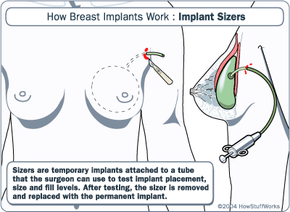Procedure
Depending on the patient and the desired outcome, breast augmentation surgery can be a very simple or very complex procedure.
After pre-operative preparation, the surgery starts by cutting one incision into the patient for each implant. The incisions are small and placed so that the scarring is minimal and hard to see. Once the incision is created, the surgeon must cut a path through the tissue to the final destination of the implant. Once that path has been created, the tissue and/or muscle (depending on placement) must be separated to create a pocket for the implant. This is where the surgeon's skill really comes into play: When deciding where to cut the pocket in the breast, the surgeon must predict what the breasts will look like once the implants are filled. In more extreme augmentation surgeries, this involves repositioning the nipple, adjusting for cleavage and creating a new crease under the breast.
Advertisement
In some cases, augmentation surgery is accompanied by mastopexy (breast lift) surgery so that everything ends up in the right place. To aid in positioning, the surgeon may decide to use a sizer or disposable implant. Sizers are temporary implants attached to a tube that the surgeon can work inside the pocket and fill up to test placement, implant size and fill levels. Once this has been tested, the sizer is removed and replaced with the permanent implant.
When inflatable implants are used, they are rolled up like a cigar and pushed into the incision, through the channel and into place. This is true no matter which type of incision is used (we'll talk about incisions in the following sections). Once the implant is positioned, the incision is closed. In the last step, the surgeon uses a syringe to fill the implant with saline through the valve, filling it to the predetermined size.
If the patient has opted to use pre-filled implants, the incision will be larger. Inserting textured, pre-filled implants requires the longest incision, providing more room for inserting an implant with a rough shell and for manipulating the less-pliable implant once it's in place.
Plastic surgeons can use one of four different types of incisions to insert the implant into the breast: peri-areolar, inframammary fold, transaxillary, and TUBA. In the next sections, we will learn the difference between these types of incision.
